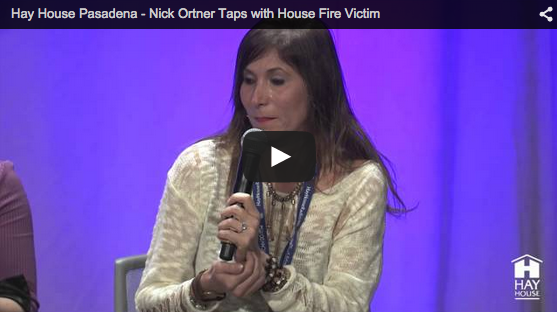One of the steps to manifesting your greatest self is to understand why your body behaves the way it does when anxiety, stress, or fear set in. To help, I’m sharing the entire chapter for Day 11 of my book, “The Tapping Solution for Manifesting Your Greatest Self”. Enjoy!

By all appearances, the polar bear, the rabbit, and the possum are dead. Their eyes are open, but their gazes are completely still. When a human approaches and moves their limbs, even rolling their entire bodies from side to side, none of the animals react. Their bodies are stiff, as if in rigor mortis.
Seconds turn into a minute, maybe longer, but still no visible signs of life.
With no warning, the polar bear’s body begins to twitch, then shake. His eyes still appear fixed, as if in a trance. The shaking grows more intense. The bear’s mouth begins making small biting movements, and his paws appear to be scratching at something.
This enormous, powerful animal seems to be fighting off some kind of attack, yet he lies on its back, biting and clawing at thin air.
The shaking soon overtakes the bear’s entire body. His massive frame convulses continuously, as if acting out his instinctive desire to fight back against attack.
It’s quite a sight watching this animal in the throes of what seems like a seizure. Yet it’s unclear exactly what’s happening or what’s coming next.Will he “come to” when we least expect it? Will he jump up and attack for real? Will he return to a nonresponsive state? It’s impossible to tell.
His body’s shaking and convulsing slow down, then stop. He takes a few deep inhalations and exhalations that appear purposeful as well as effective. Seconds later, the bear rises to his feet, resuming his normal stride without any indication of physical or mental damage.
Similarly, the possum and rabbit also lying on their backs, paws extended up in the air, their bodies completely still.
Without warning, their bodies begin to twitch. Each animal then rolls onto its stomach, gets up, and scurries away. Again, there is no sign that they’ve been hurt. In fact, they seem perfectly fine, as if the entire episode never happened.
Have you ever heard the expression “playing possum”? When animals in the wild are threatened by predators but unable to fight or flee, some are known to play dead. Also known as the freeze response, this reaction to trauma is a powerful survival technique.
Some predators require a chase and/or fight to stimulate their hunger, and in its absence, they simply lose interest. By playing possum, potential prey are able to survive situations that would otherwise lead to certain death.
Once the need for playing possum has passed—the predator has lost interest and wandered off—animals literally shake off the trauma they’ve survived. This process of releasing the aftereffects of trauma from their bodies prevents longterm damage to their mental, emotional, and physical states.
The freeze response is an equally instinctive survival technique in humans when we feel powerless against attack, whether that attack is physical or emotional. Unfortunately, unless and until we shake the trauma off, or release the trauma from the body and “primitive brain,” we remain stuck, to varying degrees, in a traumatized state.
Yesterday we looked at releasing painful events from childhood. Today we move that process further along by examining where in your life you feel frozen, unable to take action, make changes, and/or show up as you want and expect to.
If you don’t immediately recognize the freeze response in yourself, stay with me. It often takes a little digging around to notice the role it’s playing in your life.
THE “FROZEN” BRAIN
It was a nice morning in September 1999 when Stan Fisher and Ute Lawrence, a professional couple in their 40s, set out to drive from their home in Ontario, Canada, to a business meeting in Detroit.
About halfway into their journey, visibility was suddenly reduced to zero by a wall of dense fog. Unable to see in front of the car, Stan hit the brakes, narrowly avoiding an enormous truck. Their car soon came to a standstill sideways on the highway.
The next several seconds were a blur of screeching and crashing sounds, some coming from their own car being hit and then jolted repeatedly in several directions.
Stan and Ute’s car was number 13 in an 87-car pileup, the worst road disaster in Canadian history.
Following the deafening cacophony was an eerie silence. As soon as the car stopped moving, Stan sprang into action, desperately trying to open doors and windows. Nearby cars caught on fire, and both Stan and Ute heard people screaming for their lives.
Neither could help, as they themselves were trapped inside their car, which was partially wedged underneath an 18-wheeler.
Eventually someone reached their car, fire extinguisher in hand, and smashed Stan and Ute’s front windshield. After being lifted out, Stan reached in to help Ute, who sat paralyzed in her seat, unable to move or speak.
Eventually both of them were taken by ambulance to the hospital, where they were examined. Their cuts and bruises were bandaged, and both were deemed otherwise physically unharmed.Three years passed before Stan and Ute sought out help for their recurring PTSD symptoms, which included difficulty sleeping, irritability, and increased alcohol intake to numb their painful memories.
To begin their trauma recovery treatment, Stan’s and Ute’s brains were scanned separately. Stan went first. As he was prompted to recall sights, sounds, and smells from the crash, he went into a full-fledged flashback. His brain quickly became overly activated in areas associated with fleeing and fighting. His heart also began to race, his body perspired, and his blood pressure rose to dangerously high levels.
Ute’s brain scan showed something different altogether. Upon being prompted to recall sensory experiences from the crash, her brain showed decreased activity; it essentially went quiet. Her heart rate also slowed down. She didn’t sweat or show any bodily signs of fleeing or fighting.
Both Stan and Ute were stuck in the trauma they’d survived, but each was having a different experience. While Stan’s body went into an immediate, extreme fight-or-flight response, Ute froze. Her mind went blank, and her body was rendered immobile.
Ute’s freeze response, her trauma therapists learned, dated back to early childhood. After Ute’s father died when she was very young, Ute had been forced to live with her mother, a harsh and hypercritical woman. As a young child, Ute’s only defense was to numb out and disappear mentally and emotionally from her circumstances. When faced with trauma as an adult, Ute reenacted
this same response.
When the old brain takes over, it partially shuts down the higher brain, our conscious mind, and propels the body to run, hide, fight, or, on occasion, freeze . . . If for some reason the normal response is blocked—for example, when people are held down, trapped or otherwise prevented from effective action . . . the brain keeps secreting stress chemicals, and the brain’s electrical circuits continue to fire in vain. Long after the actual event has passed, the brain may keep sending signals to the body to escape a threat that no longer exists.
Since the freeze response is most likely to happen when we feel powerless, it’s especially common in children, including in situations that aren’t life threatening. Lack of affection, harsh treatment, excessive punishment, and more can all feel traumatic to a child. The “primitive brain” then responds as if the situation is life threatening. Since fighting or fleeing often isn’t possible for children,
they’re most likely to resort to the freeze response.
As adults this freeze response can play out in many different parts of our lives, preventing us from speaking out, being our true selves, confronting those who have betrayed us, responding to conflict, and more. The freeze response can also contribute to self-defeating behavior, including various forms of self-sabotage.
It can also hold us back from making important life changes that we know we need to make . . . but somehow never do. It’s only when we release the freeze response on a somatic (body) level that
we’re able to move past it.
THAWING OUT
Whereas the polar bear, possum, and rabbit all instinctively understand that they have to release trauma from the bodies, often by trembling or shaking, as humans we’re encouraged to numb out—to “get over it,” “move on,” or take medication intended to treat our symptoms.
Even those of us who have done our best to “do the work” may not have found relief. Recent research suggests that talk therapy alone often fails to resolve trauma symptoms and, in fact, may retraumatize survivors.
While these treatments can be important parts of the trauma healing process, none of them address the underlying imprint of trauma on the body and primitive brain. Because we’re encouraged to suppress trauma rather than face it, the original helplessness we felt when we were first traumatized only magnifies.
Once we’re able to let go of the somatic imprint that trauma leaves behind, we’re once again free to respond, even defend ourselves when necessary.Think for a moment . . .
How would you feel if you could say what you’ve always wanted to say? How would your body feel if you could strike out against someone who hurt you? How powerful would you feel if you could fight back or escape from harmful people/situations?
Repeatedly over the years, I’ve tapped with people who, decades later, are frozen by early “little t” as well as “Big T” trauma. As we’ve tapped through the memory, they’ve reenacted the action or spoken the words they meant to do or say but never could.
Once they do that, they’re finally able to reinhabit their bodies and reclaim their power. At that point they no longer need to resort to the freeze response to defend themselves; they can protect themselves consciously and without carrying excess stress from past events.
The key to lasting relief from the freeze response, as we’ll see, is to use tapping to revisit the trauma or event that caused you to freeze. While tapping, you can take the action you wanted to take but couldn’t, say the words you wanted to say but never did. Using this process, you can release the freeze response on emotional, mental, and somatic levels.
ON CREATING A SENSE OF SAFETY
The freeze response can result from a wide variety of experiences, especially when the response originates in childhood. If you are a “Big T” trauma survivor, keep in mind that trauma that happened decades ago may still be stuck in your body and primitive brain.
To heal from “Big T” trauma using tapping, I strongly suggest that you work with a certified EFT practitioner who can create a safe space for exploring and releasing the trauma you survived. For particularly challenging traumas, search out a psychologist or psychiatrist who is trained and incorporates tapping into their practice.
For a list of EFT practitioners, visit http://thetappingsolution.com/eft-practitioners.
To restore a sense of calm and safety in the present moment, you may also want to tap through the All Is Well Tapping Meditation script in this book.
FREEING YOURSELF FROM FREEZE
Now it’s time to use tapping do what the polar bear, possum, and rabbit all knew they needed to do—release the event or trauma they’d survived on physical, emotional, and mental levels.
First, take a moment to notice where in your life you are having some kind of freeze response . . .
Do you hold back from speaking your mind in meetings?
Do you clam up with family, or fail to show up how you intend to?
Do you avoid talking about money or seeing a doctor when you know it’s necessary?
Where in your life are you holding back—in your marriage, as a parent, in your career and/or finances, with certain people, or in specific situations?
Your freeze response may be as simple as being confronted about something and your mind going blank, or it may be looking forward to visiting family, only to find you’re irritable and angry in their presence.
There may also be a specific event that caused you to freeze, such as an encounter, a conversation, and so on. Identify one instance, relationship, or area in your life where you tend to
freeze in some way.
Focus on that one person, circumstance, or event that does, or has, caused you to freeze. Imagine being in that moment, notice any sensations you experience, as well as emotions that come up.
Next rate the emotional intensity (or lack thereof, as we saw with Ute) on a scale of 0 to 10.Take three deep breaths.
We’ll begin by tapping three times on the Karate Chop point.
KC (repeat three times): Even though I have this freeze response, and it feels so hard to overcome, I love myself and accept how I feel.
Eyebrow: This freeze response
Side of Eye: I freeze
Under Eye: I don’t act/react the way I intend to
Under Nose: I freeze
Under Mouth: This freeze response
Collarbone: It’s in my brain
Under Arm: It’s in my body
Top of Head: When did it start?
Eyebrow: This freeze response
Side of Eye: Why does it happen?
Under Eye: When did it start?
Under Nose: Why do I freeze like that?
Under Mouth: This freeze response
Collarbone: It’s safe to look at this
Under Arm: It’s safe to look at when and where it started
Top of Head: I’m safe looking at my freeze response
Eyebrow: I can relax when I think about it
Side of Eye: I can stop judging myself for having this freeze response
Under Eye: It’s safe to look at this
Under Nose: It’s safe to feel safe
Under Mouth: Even though I freeze, it’s safe to feel safe
Collarbone: I can feel calm when I look at this
Under Arm: I can feel safe in my body when I think about this response
Top of Head: Feeling relaxed and safe now
Take a deep breath. Again rate the emotional intensity (or lack thereof) on a scale of 0 to 10.
Keep tapping until you feel the desired level of safety with looking at your freeze response. You can use your own words, or continue with multiple rounds of the text above.
When you’re ready, continue tapping as you tell the story of the event or person that caused you to freeze. As you recall instance(s) where you resorted to the freeze response, include
any physical sensations, emotions, and sensory details—sights, sounds, smells—that come to mind.
While tapping through the story, also ask yourself questions like:
What do I need to say, but never did?
Are there actions I need to take to defend myself or express my emotions?
(If you have the urge to punch, kick, or physically strike out against someone who hurt you, make sure there’s enough clear space around you that you don’t hurt yourself or anyone else. And it probably doesn’t need to be said, but we’re doing this to release the trauma, not to hurt or attack anyone physically.)
Tap through the points as you let yourself release the words and fight-or-flight urges you have needed to experience but never did.
Karate Chop . . . Eyebrow . . . Side of Eye . . . Under Eye . . . Under Nose . . . Under Mouth . . . Collarbone . . . Under Arm . . . Top of Head . . .Karate Chop . . . Eyebrow . . . Side of Eye . . . Under Eye . . . Under Nose . . . Under Mouth . . . Collarbone . . . Under Arm . . . Top of Head . . .
Karate Chop . . . Eyebrow . . . Side of Eye . . . Under Eye . . . Under Nose . . . Under Mouth . . . Collarbone . . . Under Arm . . . Top of Head . . .
Keep tapping until you can focus on that event or person and not experience any emotional charge.
The next part of the chapter goes into a daily challenge, as with each of the 21 days (chapters) in the book. These really help to fine-tune your focus on applying each daily subject to your own personal life.
To pick up your own copy of “The Tapping Solution for Manifesting Your Greatest Self” go here!
Until next time…
Keep Tapping!
Nick Ortner











Connect With Us on Social Media